Faithfull Finger Ring Replicas of the Celts, Romans, Vikings and the Middle Ages
Here you can buy authentic finger ring replicas according to historical models.Continue ...
Retailers for LARP or medieval re-enactment are welcome to register for our medieval wholesale store.
Products
show 1 to 37 (out of a total of 37 articles)
Dealers for museum supplies, medieval and Viking re-enactment or LARP are cordially invited to register as retailer for wholesale in Pera Peri's medieval shop. We guarantee the best quality at good prices with short delivery times!
The development of the finger ring from antiquity to the Renaissance
 The historical rings in the assortment at Pera Peris
The historical rings in the assortment at Pera Peris
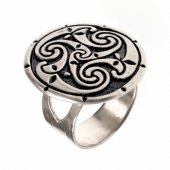 In the category Finger rings you can buy a nice assortment of historical rings from the jewellery collection of Pera Peris - House of History. Here you can find Celtic and Roman finger rings as well as rings from the Viking Age and the Middle Ages, which were made after original finds or in close connection to historical models.
In the category Finger rings you can buy a nice assortment of historical rings from the jewellery collection of Pera Peris - House of History. Here you can find Celtic and Roman finger rings as well as rings from the Viking Age and the Middle Ages, which were made after original finds or in close connection to historical models.We offer you high-quality museum replicas of finger rings from different epochs and countries, so that you can choose from a wide range of products, which then as now were an indispensable part of personal jewellery and were worn in antiquity and the Middle Ages by men and women alike.
All our replicas of historical finger rings are made of high-quality bronze in a noble, yellow-golden alloy. You can also buy our finger rings in genuine silver plated. They are provided with an extra strong silver layer of up to 10 Mg.
In addition, all historical finger rings from the Pera Peris collection are provided with a professional tarnish protection, which prevents oxidation of the surface - so you don't have to worry about green or black spots on your fingers and the metal doesn't darken, but remains beautiful and shiny.
In antiquity and also with the Germanic tribes and Vikings, it was often customary to work with finger rings not closed, but with a ring open at the bottom, so that one could adjust the size at will and adapt it to the respective finger.
The historical finger rings from the Pera Peris assortment are also adjustable and can be bent a little tighter or wider depending on the size required. Each ring is always made in three different sizes, which guarantees that rings from our collection fit every wearer perfectly.
 The finger ring fashion of our ancestors
The finger ring fashion of our ancestors
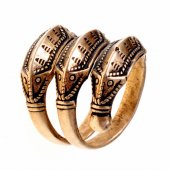 The oldest finger rings known today are over 21,000 years old - an important example of a finger ring made of mammoth ivory comes from Pavlov in the Czech Republic.
The oldest finger rings known today are over 21,000 years old - an important example of a finger ring made of mammoth ivory comes from Pavlov in the Czech Republic.Early finger rings were made of bone, bone, horn and probably also of wood and amber. But since the people of antiquity had discovered bronze, silver and gold as a material for jewellery, they also decorated their fingers with rings made of metal.
Finger rings were not only used as jewellery, but were also valuable objects, which in prehistoric times also served as a means of exchange and payment.
With the ancient Egyptians, rings were often provided with divine attributes and characters, since jewellery was not only a simple end in itself, but was usually seen in connection with magic and belief in gods and the early people promised themselves salvation and blessings.
From Ancient Greece and the Roman Republic, numerous finger rings have been handed down, with which not only the ladies of high society, but also the men knew how to adorn themselves.
The Celts of the Latène period, i.e. the pre-Roman, Celtic period and later the Iron Age Germanic tribes also wore finger rings according to the Roman models.
The Vikings, Slavs and people of the Middle Ages finally designed new forms of finger rings, which were often made of flat plates or braided wires, until in the Renaissance the treasure of forms of antiquity was rediscovered and rings based on the antique model once again found their way into jewellery fashion.
 The Finger Rings of the Antiquity
The Finger Rings of the Antiquity
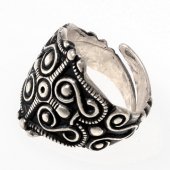 Especially the signet ring, which quasi replaced the current signature and carried the sign of an assigned owner, was already very common in Greek antiquity.
Especially the signet ring, which quasi replaced the current signature and carried the sign of an assigned owner, was already very common in Greek antiquity.The personal seal in the form of a finger ring could thus always be carried with you and was available at any time.
On the one hand, there were signet rings with an inscription or rings with a figurative, sometimes even allegorical representation. Antique finger rings were often made of bronze, silver or gold, but coloured glass, enamel and semi-precious stones were also used.
But not only around the Mediterranean Sea, also in the European north finger rings were worn around 1500 c. BC. Very typical in the Bronze Age was the so-called spiral ring, a bronze wire with several turns on top of each other with ends twisted into spirals.
These Bronze Age spiral rings could have up to twenty turns and were worn in different strengths as finger rings, arm rings and even rings for the legs.
Especially the Etruscans, the predecessors of the Romans, refined the jewellery design of granulation, already known in Egypt, by using small gold beads and brought it to the highest technical precision.
In addition to pendants, brooches and bracelets, the Etruscans also decorated finger rings with the application of granules, but relief and filigree techniques were also used.
Etruscan rings were often also decorated with plates in the form of cartouches or scarabs made of carnelian.
 The Finger Rings of the Romans
The Finger Rings of the Romans
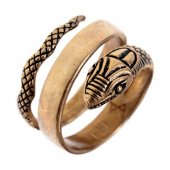 The Romans adopted many techniques and craftsmanship from the Etruscans. Not only precious gemstones were often used by the Romans as part of their finger rings, even simple iron rings were in use and were considered a Spartan ideal in the early days of the Roman Republic, with which a civic pride was associated.
The Romans adopted many techniques and craftsmanship from the Etruscans. Not only precious gemstones were often used by the Romans as part of their finger rings, even simple iron rings were in use and were considered a Spartan ideal in the early days of the Roman Republic, with which a civic pride was associated.Gold rings were only allowed to be worn by senators in those days, and only on official occasions. However, with the beginning of the Roman Empire around the birth of Christ, this custom changed and rings made of gold and precious stones spread increasingly, even Roman jewellery became common throughout the Mediterranean region.
During this time, so-called gems were often used to create Roman finger rings, whose carnelian incised decorations borrowed motifs from the Roman world of gods, animals and legends.
As was the case with the Greeks, signet rings were worn on a large scale from the imperial period to late antiquity.
The Roman politician and commander Pompeius, for example, was in possession of a valuable signet ring showing a lion with a sword in its paws. The signet ring of Julius Caesar, however, showed an armed Venus.
Jewellery served the Romans primarily as a symbol of wealth and power - so not everyone, but only freeborn Romans were allowed to wear a signet ring made of gold or precious stones. But towards the end of the Roman Empire, even Roman women wore a signet ring.
In addition to the use of gemstones for color accentuation, the breakthrough technique, "opus interrasile", was also used for finger rings, which gave the Roman finger rings lightness and elegance.
The Byzantines who followed the Romans adopted their technique of gem cutting and the breakthrough technique for rings, but increasingly included Christian signs and themes.
Thus, the ancient forms were increasingly replaced by Christian-influenced motifs and the pictorial representations were increasingly replaced by easier to make lettering and monograms.
Roman and Byzantine wedding rings often had inscriptions on the inner ring band.
Frequently one finds, for example, the saying "Pignus amoris habes" - "You have pledged my love".
As a forerunner of today's wedding rings, a ring came into fashion from the 2nd century BC onwards, which was designed as a folded hand, the so-called "dextrarum iunctio".
This form of proof of love was taken up again in the high and late Middle Ages from which a whole series of finger rings with representations of hands are known. The meaning was the same, a symbol of togetherness, fidelity and solidarity.
However, in the early Romans only the women wore a wedding ring, which was also usually made of iron and was considered a sign of commitment, but perhaps only a kind of "receipt" for the dowry...
In contrast to our tradition, the Romans, like today's Italians, wore the wedding ring on their left hand because it was believed that a vein, the so-called vena amoris, the vein of love, ran directly from this finger to the heart.
In addition to signet rings and finger rings in the shape of snakes, simple rings with gemstones or gems made of carnelian, there were also so-called key rings, which, in the function of wedding rings, expressed dominion over house and court. Other Roman rings bore engraved short wishes, such as the popular saying "utere felix", which means "use your luck".
A bit piquant, however, is the fact that since ancient times the poison ring is also known, a ring with a container that could be opened and then be inconspicuously emptied into a drink or food. Still in the Renaissance, the poison ring is said to have been a popular prop for maintaining power...
 The Rings of the Celts
The Rings of the Celts
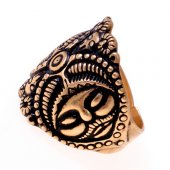 The jewellery design of the Celts created in the Hallstatt period mainly finger rings with geometric patterns in the form of decorations with triangles, circles and diamonds.
The jewellery design of the Celts created in the Hallstatt period mainly finger rings with geometric patterns in the form of decorations with triangles, circles and diamonds.Under Greek and Etruscan influence, the Celtic Latène culture developed at the end of the 6th century BC, which incorporated Mediterranean ornaments and motifs.
In the beginning, naturalistic motifs such as faces and animals dominated in Latène culture in sculptural representations. The Celts of the Latène period also integrated images of palmettes and acanthus tendrils into their jewellery designs.
In the later Latène period, plastic whirl ornaments and knot patterns appeared on rings and were developed into complex patterns of intertwined spirals, tendrils and bows, thus separating the Celtic jewellery style from the Mediterranean models.
Finger rings from the Latène period were found only very rarely, but they were mostly made of bronze. In the early Celtic princely tombs, however, splendid finger rings made of pure gold were sometimes found.
 The Rings of the Germanic Tribes
The Rings of the Germanic Tribes
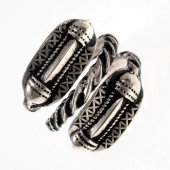 The early historical Germanic tribes, especially in northern Europe, used spiral wires made of bronze, silver and occasionally gold as a means of payment.
The early historical Germanic tribes, especially in northern Europe, used spiral wires made of bronze, silver and occasionally gold as a means of payment.Even 1000 years later, in the Viking Age, such simple spiral rings were still in circulation as so-called hack silver as a means of payment.
From the early Germanic spiral rings, snake-shaped finger rings developed until the 3rd century, which could possibly also have snake heads after the Roman model and were decorated with various ornaments.
Since such finger rings were also found between the weapons in the moor find of Thorsberg, it can be seen that finger rings were worn not only by women but also by men in the Northern Germanic period.
Especially among the Germanic tribes in southwestern Scandinavia, such snake rings were very common and could have up to 8 heads in multiple turns, but such Germanic snake rings were also found in Roman settlements and military camps in the Roman occupied territories in Western Germany along the Rhine.
It is possible that the snake was regarded by the Romans and the Germanic tribes as a parable for healing because already in the Greek antiquity the snake was mentally connected with the art of healing. Even today, the symbol of the staff of Asclepius stands for medicine itself.
If one considers that the snake regularly sheds its skin, the symbol of the snake can possibly also be seen as a parable for eternal youth, which was somehow relevant as a theme for people in probably all epochs.
In the course of the migration of peoples, the Germanic tribes in the 4th and 5th century A.D. developed from their own sense of art a new independent jewellery design far from Roman influences, which resulted in an abstract animal ornamentation and was designed with elaborate granulation and filigree techniques as well as inlaid work in cloisonné with red almandines.
Christian motifs and personal names also became common as designs for Germanic finger rings.
 The rings of the Vikings and Slavs
The rings of the Vikings and Slavs
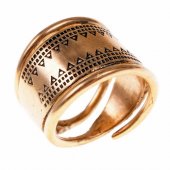 Similar to the early Germanic tribes, it was still common practice among the Vikings to use precious metals for payment by weight, due to the coinage system still in development.
Similar to the early Germanic tribes, it was still common practice among the Vikings to use precious metals for payment by weight, due to the coinage system still in development.Thus, it was possible to wear finger rings made of thin bronze or silver wires and laid in several turns, from which a smaller or larger piece could be broken off as needed.
It is therefore not surprising that rings were often used by the Vikings as so-called hack silver and were sometimes worn only as secondary jewellery.
On the other hand, jewellery was an important status symbol during the Viking Age and a Viking who was rich enough to afford jewellery, showed this. It was no different with the Slavs.
Thus, in addition to magnificent brooches and heavy bracelets, numerous finger rings from the Viking Age from Scandinavia to England and Russia were found.
The finger rings of the Vikings were mostly made of simple, wound brass or silver wires and were worn by men and women alike. But in England was also found a remarkable example of a Viking rune ring. In addition, there are simple, flat rings with triangular ornaments and relief embossing or circular eye motifs.
But the Vikings also wore high-quality, braided finger rings made of bronze, silver and, more rarely, gold and decorated with filigree pearl wires. Rings with gemstones did not occur as jewellery with the Vikings, with a few exceptions.
From the Edda of the Vikings we know the magical ring Draupnir, a valuable golden ring of gods, which according to legend was once created by the two dwarves Sindri and Brokk and which was made a gift to the father of the gods Odin by a bet with Loki.
The ring Draupnir had the special property of draining off every ninth night equally heavy and precious rings. On the other hand, the ring Draupnir was supposed to give its owner invisibility and fulfil wishes.
In the Skirnir song of Edda, Skirnir, friend of the Nordic god Freyr, rides for him to the giant kingdom to look for a bride and offers the ring Draupnir to the giant daughter Gerda as a wedding present, which she refuses, however, because she already possesses enough gold.
 The Rings in the Middle Ages
The Rings in the Middle Ages
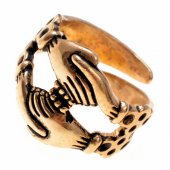 Like among the Germanic and Viking peoples, bronze, silver and gold were as well the main materials used to make rings in the Middle Ages. But lead, leg, gagat and glass rings were also common.
Like among the Germanic and Viking peoples, bronze, silver and gold were as well the main materials used to make rings in the Middle Ages. But lead, leg, gagat and glass rings were also common.In the High Middle Ages of the 12th century, the use of gemstones, which had been out of fashion since late antiquity, revived. The gemstones were mostly polished cabochons and simply faceted stones were rather the exception, with rubies, sapphires, almandines, amethysts, rock crystal and even rough diamonds being used.
The art of stone cutting in intaglios and cameos experienced a new flowering.
In the high Middle Ages, finger rings were not only worn as jewellery by those who could afford them, but, depending on the design, were also an expression of religious fervour or a sign of mutual affection.
Especially rings with inscriptions were highly valued in the Middle Ages, with finger rings in the form of a stirrup were very common.
Seal rings were also still in use during the high Middle Ages and served as a sign of social standing. Abbots and abbesses also wore precious rings as an expression of their office.
In the 15th century it became customary to wear several rings on both hands at the same time, whereby only the middle finger was left out, which was already considered an indecent finger by the Romans...
Unlike in Roman times, the ring was no longer reserved for a certain social class in the Middle Ages, but moral laws in the 14th and 15th century finally restricted the wearing of jewellery.
 The rings from the Renaissance
The rings from the Renaissance
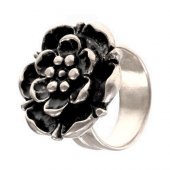 Due to the fact that portrait painting began to flourish from the 16th century onwards, we now have an idea, down to the smallest detail, of what kind of ring a wealthy person wore in the Renaissance.
Due to the fact that portrait painting began to flourish from the 16th century onwards, we now have an idea, down to the smallest detail, of what kind of ring a wealthy person wore in the Renaissance.And it can be said that in the Renaissance men and women wore rings of every shape and design. Especially finger rings with gemstones with triangular facets, the so-called rose cut, became common at the end of the 16th century, with diamond rings the so-called table cut was predominant.
In some religious orders, nuns and sisters also wore a finger ring after their solemn profession, which was regarded as a bridal symbol of attachment to Christ.
Abbot, bishop and cardinal also wore a finger ring as the insignia of their office, the pope the so-called fisherman's ring, often adorned with an amethyst, the stone of grace and wisdom.
We would be pleased if you enjoyed this little excursion to the historical finger rings of antiquity and the Middle Ages and you might find a matching ring made of bronze or in silver-plated, which you would like to wear with your historical garb or maybe even as finger ring in everyday life.


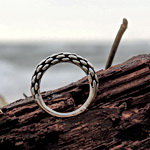 Are you looking for a faithful replica of a medieval or Roman finger ring for your historical clothing? In our medieval shop you will find a nice selection of true to detail replicas of historical finger rings, regardless of whether from the time of the Romans and Celts, Teutons and Vikings or the Middle Ages and the Renaissance.
Are you looking for a faithful replica of a medieval or Roman finger ring for your historical clothing? In our medieval shop you will find a nice selection of true to detail replicas of historical finger rings, regardless of whether from the time of the Romans and Celts, Teutons and Vikings or the Middle Ages and the Renaissance.